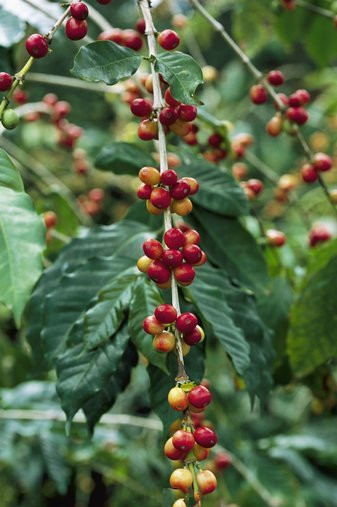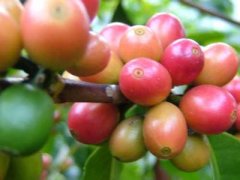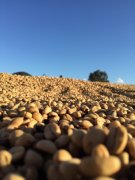Technology of high-quality coffee beans the processing process of coffee beans
After the wet treatment, the coffee beans are still preserved in the inner pericarp, which still contains about 15% water. The endocarp must be dried to a moisture content of about 11% to ensure that coffee beans are stored in a stable and safe environment. Water content is critical, because if Arabica beans are overdried to a moisture content of 10%, they will lose their original turquoise and their quality will decline.

Coffee beans covered with endocarp should be laid flat on the cement floor, slate floor, dry table or plate, which is very similar to the drying method.
Mechanical dryers are sometimes used on larger plantations or where Rain Water may disrupt the drying process. Coffee beans are placed in an air-conditioning box and the dry wind blows on the surface of the coffee beans. The drying process can also be done by the sun, and coffee beans should be turned regularly to ensure complete dryness, a process that takes 12 to 15 days. The most important thing is that the endocarp should not be cracked. If the sun is too strong, the coffee beans must be covered.
At this point, the whole process is completed, coffee beans become known as "parchment coffee beans (parchment coffee)" (because the endocarp of coffee beans is quite like parchment, it is called). In general, coffee beans are kept in this form until the eve of export.
Since countries that produce coffee beans need to export coffee beans throughout the year rather than just about three months of harvest, coffee beans should be stored in the form of "parchment coffee beans" in an absolutely stable environment. High temperature is the enemy of coffee beans, and it is easy to damage coffee beans when the humidity reaches 70%. For this reason, "parchment coffee beans" are generally not stored on farms where they are produced (although there is no choice in some places). Coffee beans grown in the highlands should be stored at or near the same altitude as the places where they are grown, as they are particularly vulnerable to humidity. In this environment, Arabica coffee beans should not be stored for more than 12 hours, while Robbins coffee beans can be stored for a little longer.
Grinding or shelling
Coffee beans should be ground before they are exported, that is, the endocarp of Arabian and Robbite coffee beans to be sold should be removed. The residual shell of coffee beans after removal and cleaning of endocarp and drying process is also known as peeling or peeling.
It is more difficult to remove the endocarp of coffee beans in the wet treatment than in the drying process, so different shelling machines are needed. There are mainly two types of machines: friction sheller and compaction sheller. Engelberg and African models of friction shellers are suitable for dry or wet coffee beans: in a cylindrical box, the coffee beans are squeezed between a linear strip and a knife, and the shell is scraped by a knife to reveal the beans.
Parchment coffee beans are usually shelled on a Smout friction sheller. Jules Smout is of Belgian and Scottish descent. He was born in Koenigsberg, Prussia, and settled in Guatemala. In 1844, he developed a coffee peeling machine with a rotating body with a screw, which rotates in a box with a screw, which rotates in the opposite direction. When the coffee bean is driven along the rotation, the endocarp is peeled off the coffee bean. Because the rotating body rotates relatively slowly, it produces less heat than other types of shelling machines.
Other shellers include rolling shellers (mainly used for dried coffee beans produced in South America) and crossbar shellers (with knives inside).
In other places except Brazil, the parchment coffee beans are treated with a pressing sheller instead of rubbing the sheller. Coffee beans must have moderate water content when shelling, or they may break. The pressing sheller consists of a horizontal disk rotating in a ring, and the edge of the plate is surrounded by an iron needle or rod. When the machine is running, the coffee bean comes into contact with the iron needle due to the action of centrifugal force, which makes the endocarp shell fall off.
Polishing
The silver skin left on the coffee beans after shelling must be removed by polishing. Most polishers work in a similar way to Smoot shellers, except that copper rods are used instead of iron rods, which cause less damage to coffee beans. Copper also plated coffee beans with a charming turquoise. Coffee beans treated with a pressure sheller are usually polished because they always look more messy than those shelled by friction.
Historically, polished coffee beans have been thought to be of higher grade than unpolished coffee beans, but in fact, it makes little difference when they end up with a drink to taste in a cup. Others stubbornly believe that the value of polishing will be affected by the quality of the cup, but it is difficult to find conclusive evidence.
Important Notice :
前街咖啡 FrontStreet Coffee has moved to new addredd:
FrontStreet Coffee Address: 315,Donghua East Road,GuangZhou
Tel:020 38364473
- Prev

Processing of high-quality coffee beans by wet treatment
The wet treatment process requires more capital investment and more energy, but this method helps to ensure the quality of coffee beans and reduce damage. The main difference between the wet and dry methods is that during the wet treatment, the pulp is immediately separated from the coffee beans instead of drying them. The pulp is separated in this way in a separator with a fixed surface and a moving surface.
- Next

The method of grading and classification of coffee beans
Coffee beans are graded first by size and then by density. With two exceptions, all coffee beans have a considerable size and the same proportion, with flat on one side and semi-oval on the other. The special cases are pea-shaped coffee beans that tend to be more oval in shape and giant coffee beans with large particles (that is, Marragol peel coffee beans). The prices of these two kinds of coffee beans are always higher.
Related
- What is the meaning of lactic acid fermentation with coffee bean treatment?
- How to judge the state of foam by sound?
- How does the latte pull out the unicorn pattern? Come to get for a little trick to improve the flower pull!
- Will flower pulling affect the taste of the latte?
- Do you know the history of coffee?
- The difference between honey treatment and sun washing what is raisin honey treatment?
- What kind of milk can a novice use to make coffee foam to keep the foam longer? The correct method and skills of milking tutorial sharing
- Why do washed coffee beans taste sour? Flavor characteristics of washed Coffee
- Introduction to the skill of how to practice the size and height of water injection around the circle of hand-brewed coffee
- How do beginners practice coffee flower drawing from scratch?

